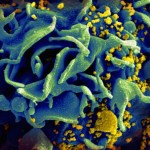courtship
Scientists use a 'gene gun' to insert a gene from a flowering plant called rockcress into the cells of wheat seeds. The genetically modified wheat became more resistant to a fungus called take-all, which in real life can cause "a 40-60% reduction in wheat yields."
T-cells from six HIV+ patients were removed from their bodies, treated with a zinc-finger nuclease designed to snip a gene out of the cell's DNA, and put back in the patients. Removal of the gene mimics a naturally occurring mutation which confers resistance to the HIV virus. But only 25% of the treated cells showed…
To our ears, the buzz of a mosquito is intensely irritating and a sign of itchiness to come, but to theirs, it's a lover's serenade. The high-pitched drone of a female is a siren's song that attracts male mosquitoes. And a new study shows that when the two love-bugs meet, they perform a duet, matching each other's buzzing frequency with careful precision.
The female Aedes aegypti mosquito (the carrier of both dengue and yellow fever) beats her wings with a fundamental frequency of about 400Hz, producing a pitch just slightly lower than concert A. Males on the other hand, have a …
tags: Parrots in the Land of Oz, parrots, behavior, Australia, nature, ornithology, streaming video
Did you know that budgerigars, Melopsittacus undulatus -- erroneously known as "parakeets" in the United States -- can see UV light? Did you know that female budgerigars rely on the UV reflectance to judge the quality of potential mates? This is a fascinating little trailer about wild budgerigars from the Nature program Parrots in the Land of Oz, which airs on PBS on 19, 20 and 21 October [1:43]
tags: Parrots in the Land of Oz, parrots, behavior, Australia, nature, ornithology, streaming video
Did you know that several species of cockatoos are black instead of white in color? Did you know that the Black Palm Cockatoos, Probosciger aterrimus, use tools -- tree limbs that they use to beat on their chosen nest cavity -- to attract a mate? Below the fold is a clip of the courtship of a pair of Black Palm Cockatoos from the Nature program Parrots in the Land of Oz, which airs on PBS on 19, 20 and 21 October [1:56]
You might not be that impressed to receive a clump of grass or branches on a first date, but a boto dolphin might think differently. A new study suggests that these Amazonian dolphins wave bits of flotsam to attract mates.
The boto is a freshwater river dolphin that swims through the currents of the Amazon and the Orinoco. They are elusive creatures that are difficult to study, so very little is known about their social lives.
Tony Martin from the University of St Andrews spent three years in the Amazonian Mamiraua reserve studying the behaviour of botos. During this time, he spotted over…
Jumping spiders have exceptional vision and therefore, their courtship displays have a highly visual component. This nifty video shows a male jumping spider doing its equivalent of the Booty Drop. Make sure to have your volume on.
For more MTV Grind worthy jumping spider action, check out the Tree of Life Web Project.
A nearly extinct species of hummingbird has been captured on film for the first time demonstrating its spatula-crazed mating dance. The aptly named Marvelous Spatuletail lives in a single, isolated valley in northern Peru. There are only 350 - 1,000 thought left to exist. The video really is extraordinary.
Marvelous Spatuletail, Lodigesia mirabilis digg_url='http://zooillogix.blogspot.com/2007/04/marvelous-spatula-tale.html';
